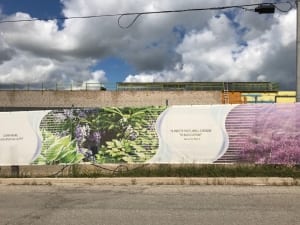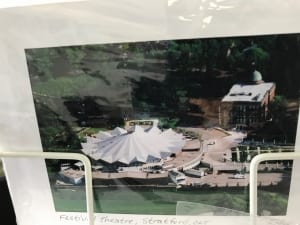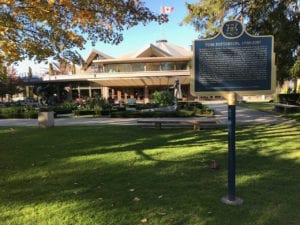PhD dissertation by Lauren Acton highlights role of musical theatre (as complement to classical theatre) in history of Stratford Festival in Canada
The positioning of Shakespeare in the public mind has changed dramatically since Elizabethan times, when the plays were viewed as suitable for all classes of society.
People in the audience – the audience, that is, ‘in the stalls,’ as the expression goes – in Shakespeare’s time were known to harangue the actors at will, if I understand correctly, and on occasion such interactions would give rise to riotous behaviours, inside and outside of theatres.

Tom Patterson Theatre Centre site, looking north from Water Street, Aug. 27, 2019. The rectangle in the foreground has at this stage not yet been covered in a layer of bricks. Jaan Pill photo
That said, I will have to read more widely and closely about audience behaviours in Elizabethan times, with a focus on citations of sources, as I have to date tended to soon forget whatever I have read about such topics of interest.
An underlying reality is that the theatre as an institution needs financial resources in one form or another in order to exist.
Shakespeare plays now tend to be seen as a more highbrow experience.
Theatre, like many things in life, operates according to a socially constructed pecking order.
Speaking of highbrow, middlebrow, and lowbrow is one way among others to conceptualize such a hierarchy.
It’s a really positive thing that public school groups – which represent a wide range of socioeconomic profiles – attend Shakespeare plays in Ontario.

Tom Patterson Theatre Centre site, looking east along Water Street, April 10, 2019. In the background, the Stratford Optimist Hall, a white building with a gray roof is visible. Jaan Pill photo
That means a wide range of people, at least in their formative years, have the opportunity to attend performances of Shakespeare’s works at the Festival Theatre in Stratford among other venues.
For the older crowd, it’s people with money to spare who tend to be ticket buyers at the Festival Theatre, located at the edge of parkland along the Avon River close to downtown Stratford.
Shakespeare plays and musical theatre
Some ticket buyers, as well, may not have as much money to spare but they are willing to save up enough to buy tickets, because they are really keen about Shakespeare.
I like to attend Shakespeare plays at Stratford because from my perspective, they offer a means to reflect upon the intersection of metaphor and materiality. I like to read short stories by Alice Munro for the same reason.
Aside from these forms of entertainment, reading of nonfiction, and of texts in the borderland between fiction and nonfiction (the distinction between fiction and nonfiction being in the eye of the beholder), is where much of my attention otherwise gravitates toward.
Other people, as the case may be, would care less about Shakespeare, and prefer to attend musical theatre performances at the Festival. We can add that some theatre goers enjoy both top-rate classical theatre and musical theatre, at Stratford and elsewhere.
These comments serve as introduction to random thoughts based upon a dissertation I’ve been reading.
Lauren Acton’s December 2014 PhD dissertation is available online
I’ve recently been reading Lauren Acton’s December 2014 PhD dissertation (available online), entitled:
I’ve referred to the dissertation at a previous post entitled:
A key argument that Acton makes is that, in the larger scheme of things, musicals matters just as much as classical plays and do not warrant being positioned lower, in a socially constructed pecking order.
To reduce costs of printouts, a laser printer makes good sense
When I first encountered the dissertation, I read enough of the first few pages to get a sense of what it was about.
At that time, however, it would not have occurred to me to start printing it out, for a close reading of the text, as at that time I was using an inkjet printer and I knew from experience that it would cost me plenty, by way of depletion of inkjet cartridges, to start printing out a few hundred pages at a time.
I can’t imagine reading such a lengthy document entirely online. I now print out such items using a laser printer, which is decidedly more cost effective than depending on the kind of inkjet printer I was using in the past. I’ve outlined our switch from an inkjet to a couple of laser printers (one for black and white, the other for colour printouts) at a previous post:
If you’re concerned about high cost of inkjet cartridges, a laser printer may be a better option
The above-noted dissertation shares many valuable references and reflections about the history of the Stratford Festival, and the conceptual frameworks within which such a history is embedded.
The text does not make for ease in reading. Work by a team of editors would be required, in order to eliminate typos and repetitiveness in such a text. Such editorial resources may or may not be available.

Tom Patterson Theatre Centre site, view from Water Street looking north, Sept. 7, 2019. Jaan Pill photo
The dissertation’s use of the term populist, when describing theatrical genres, would benefit from a more elaborate discussion, regarding what the term means and signifies in contemporary usage.
These minor points aside, a person can extract much of value from the dissertation, with sufficient time and effort. Topics are addressed that have received minor attention in previous accounts of the history of the Festival.
As well, the document can serve as a starting point for exploration of concepts that are hinted at within it. Even absence of certain concepts can serve as starting point for further study.
Among topics of interest in the document is the history of how productions have made use of the thrust stages at the Festival Theatre and Tom Patterson Theatre and, by way of contrast, at the proscenium arch stage at the Avon Theatre. Such detailed case studies are of tremendous value.
The Tom Patterson Theatre has now been demolished to make way for the Tom Patterson Theatre Centre, which also features a thrust stage and opens in 2020.
Meighen Forum
I’ve referred to the Meighen Forum at the Stratford Festival at a previous post entitled:
I refer to the Meighen Forum in the context of the discussion, in Lauren Acton’s dissertation, of demographic variables that come into play, when we consider who attends Festival productions, and who stays away.
Among other things, the Meighen forum post refers to a talk, at the forum, where a comment is shared that, given the price of tickets, attendance at the Stratford Festival tends to be beyond the financial resources of quite a few people.
I’ve outlined this aspect of Stratford and Southwestern Ontario at several posts including one entitled:
Tyrone Guthrie and Alec Guinness
My own introduction to the history of of the Stratford Festival has been largely through my study of land use decision making as it relates to the history of the parkland within which the Festival Theatre is located.
As well, I have learned a great deal from a close reading of memoirs by Tyrone Guthrie and Alec Guinness as I’ve noted at the landing page at the Preserved Stories website.
As I’ve come to learn, the launch of the Stratford Festival in 1953 was a most inspiring achievement.

Aerial view of Festival Theatre, Stratford. Source: Card on display on counter at Stratford Municipal Airport.
In Tyrone Guthrie’s recollection, the most influential factor ensuring the successful launch of the Stratford Festival in the early fifties was its timeliness.
Other key factors, noted by Guthrie among others, were the organizing committee; quality of the plays; construction of a thrust stage (as opposed to a standard proscenium stage); publicity by Mary Jolliffe; crucial financial resources that came through at just the right moments; and the vision and perseverance of Tom Patterson.
Guthrie viewed theatre as ritual, a characterization that the thrust stage enables. In such a ritual, audience members (seeing each other across the open stage, as they are seated on three sides of it) are at all times aware of each other’s presence. That stands in contrast to theatre as illusion, a characterization that the proscenium stage (with audience members all looking in the same direction) enables.
In Blessings in Disguise (1985), Alex Guiness describes, succinctly and with good humour, the launch of the Stratford Festival. He takes a more nuanced view, perhaps, regarding the features of the thrust stage, in comparison to Guthrie. The actor’s views and practical experience matter hugely, Guinness adds, when design decisions related to dimensions of a theatrical stage, and the like, are made.
Tyrone Guthrie’s views regarding class dynamics
I’ve discussed Tyrone Guthrie’s views regarding class dynamics at a previous post entitled:
June 2, 2019 Fly-In Charity Breakfast at Stratford airport was a most enjoyable event
Astor Place Riot
At the current post I want to share highlights from Lauren Acton’s text in which she discusses the Astor Place Riot in New York City on May 10, 1849.
As I understand, the riot played a role in ensuring that Shakespeare’s plays came to be seen, in Western society, as a preserve of highbrow audiences.
On p. 157 of her text, Acton notes:
The suspicion of a popular audience by cultural gatekeepers is part of a longstanding, class-based struggle that dates back to at least the Astor Place Riot of 1849 in America, and long before that in Europe.338
Footnote 338 reads:
See a discussion of the Astor Place Riot and the cultural fallout surrounding it in Chapter 5.
On p. 239, Acton notes:
Perhaps the most famous example of class warfare over the division of theatre is the Astor Place riot of May 10, 1849, when thousands of protesters filled the streets outside the Astor Place Opera House in New York City. A few days before, at a performance of Macbeth, the unruly behaviour of the audience in the stalls toward an English actor named William Charles Macready included throwing food and furniture on the stage. A number of prominent New Yorkers convinced Macready to ignore the mob and stay on for the remainder of his contract. He took the stage again on May 10, and the vocal protests to his performance inside were joined by a mob of supporters outside who objected to the attempts of the upper classes to regulate behaviour in the theatre. By the end of the night twenty-two people had been killed, more than one hundred injured and eighty-five working class men had been arrested.488 Stempel averred that the Astor Place Riot “marked the beginning of the end of theater in the United States as a conglomerate entertainment for a heterogeneous audience.”489 Levine wrote,
The Astor Place Riot, which in essence was a struggle for power and cultural authority within theatrical space, was simultaneously an indication of and a catalyst for the cultural changes that came to characterize the United States at the end of the century. Theater no longer functioned as an expressive form that embodied all classes within a shared public space, nor did Shakespeare much longer remain the common property of all Americans.490
Certain genres of theatre became associated with certain classes: Shakespeare and opera became the province of the social elite, while operetta (and later musicals) became middle class entertainments. The class distinctions extended from the audience onto the stage, and actors came to be associated with high art or low, depending on the genre they performed.
The following footnotes accompany the passage:
487 Ibid., 60-63. [That is, Lawrence Levine, Highbrow/Lowbrow: the emergence of cultural hierarchy in America (Cambridge, Mass: Harvard University Press, 1988).]
488 See Levine, Highbrow/Lowbrow, 63-69, and Stempel, Showtime, 27-35.
489 Stempel, Showtime, 33.
490 Levine, Highbrow/Lowbrow, 68.
CBC Ideas: Lessons from academic study of musicals
An Oct. 4, 2019 CBC Ideas article is entitled: Lessons off Broadway: Princeton professor dissects zeitgeist in musicals: ‘Most musicals are giving us double messages’, says music theatre scholar Stacy Wolf.”
An excerpt reads:
The repetitious cycle of ‘formally integrated’ musicals — where all of the songs seems to emerge from the voice of the character — gave way to self-reflexivity as the decade passed by.
“The text itself, that is the script, the music, the lyrics and even sometimes the choreography, can often be in a contradictory relationship with the performance,” Wolf explained.
“This is especially clear in musicals of the 1960s where… the character is a victim and yet the actor has a chance to stand centre-stage and sing a great song.”
Musicals encompass both conformity and rebellion, according to Wolf. By the 80s and 90s, eras characterized by corporatism, Wolf told IDEAS that musicals turned huge profits through the work of Cameron Macintosh and Andrew Lloyd-Webber.
In the category of Related Stories, the above-noted article refers to a Sept. 2, 2019 CBC article entitled: “How the Stratford Festival is evolving to keep diversity, #MeToo movement centre stage: CBC’s Jackie Sharkey and theatre critic Jesse Green examine how the Ontario festival continues to thrive.”
An excerpt reads:
According to the New York Times’ theatre critic Jesse Green, these adaptations exemplify how the renowned Ontario festival continues to stay relevant, and how to adapt — or leave behind — certain works when the conversations about gender, race and class may have radically changed since they were first written.
The Stage Is All the World: The Theatrical Designs of Tanya Moiseiwitsch (1994)
I’ve recently been reading The Stage Is All the World: The Theatrical Designs of Tanya Moiseiwitsch (1994), borrowed from the Stratford Public Library.
The Stage Is All the World underlines the impressive and efficient working method that gave rise to all of the key components driving launch of the Stratford Festival in 1953.
It underlines as well that art by its nature draws nourishment from that which is local and national, and concurrently in its finest moments steps far beyond that which is strictly national.
A blurb for the study reads:
Published in conjunction with an exhibit organized by the David and Alfred Smart Museum of Art at the University of Chicago, and scheduled to appear in several cities during 1994 and 1995. Moiseiwitsch is one of the most celebrated figures in the field of theatrical design; her half-century-long career has been characterized by constant experimentation, innovation, and variety. This publication features 140 sketches and photos of costumes, masks, and models, accompanied by an introduction, contributed essays, and interviews. Distributed by the U. of Washington Press. 10×9.5″ Annotation c. by Book News, Inc., Portland, Or.




Leave a Reply
Want to join the discussion?Feel free to contribute!